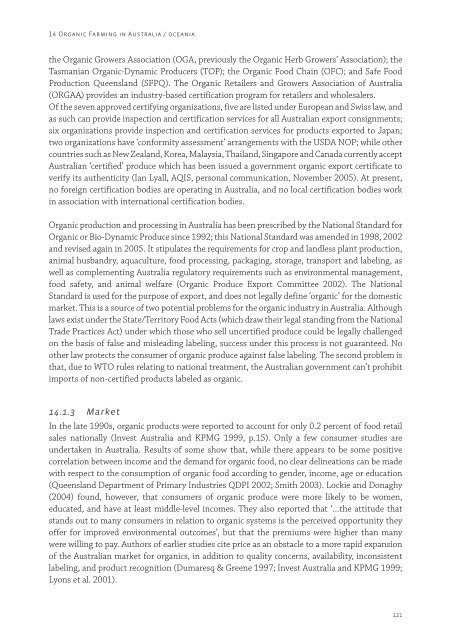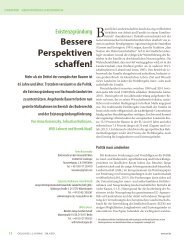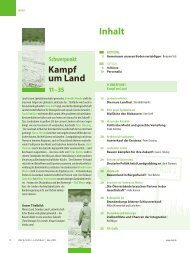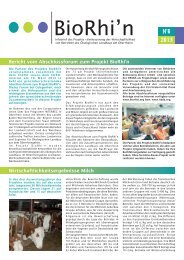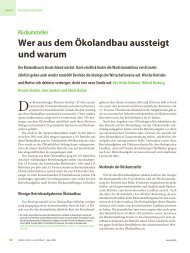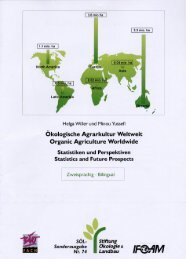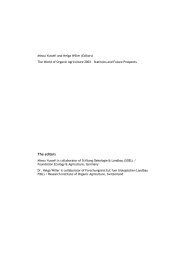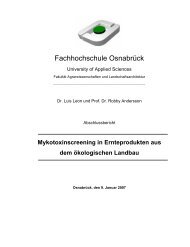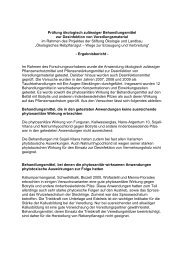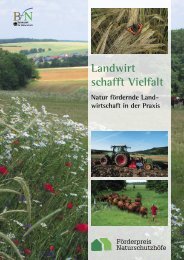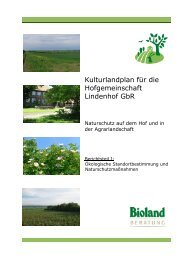the world of organic agriculture - Organic Eprints
the world of organic agriculture - Organic Eprints
the world of organic agriculture - Organic Eprints
You also want an ePaper? Increase the reach of your titles
YUMPU automatically turns print PDFs into web optimized ePapers that Google loves.
14 <strong>Organic</strong> Farming in Australia / oceania<br />
<strong>the</strong> <strong>Organic</strong> Growers Association (OGA, previously <strong>the</strong> <strong>Organic</strong> Herb Growers’ Association); <strong>the</strong><br />
Tasmanian <strong>Organic</strong>-Dynamic Producers (TOP); <strong>the</strong> <strong>Organic</strong> Food Chain (OFC); and Safe Food<br />
Production Queensland (SFPQ). The <strong>Organic</strong> Retailers and Growers Association <strong>of</strong> Australia<br />
(ORGAA) provides an industry-based certification program for retailers and wholesalers.<br />
Of <strong>the</strong> seven approved certifying organizations, five are listed under European and Swiss law, and<br />
as such can provide inspection and certification services for all Australian export consignments;<br />
six organizations provide inspection and certification services for products exported to Japan;<br />
two organizations have ‘conformity assessment’ arrangements with <strong>the</strong> USDA NOP; while o<strong>the</strong>r<br />
countries such as New Zealand, Korea, Malaysia, Thailand, Singapore and Canada currently accept<br />
Australian ‘certified’ produce which has been issued a government <strong>organic</strong> export certificate to<br />
verify its au<strong>the</strong>nticity (Ian Lyall, AQIS, personal communication, November 2005). At present,<br />
no foreign certification bodies are operating in Australia, and no local certification bodies work<br />
in association with international certification bodies.<br />
<strong>Organic</strong> production and processing in Australia has been prescribed by <strong>the</strong> National Standard for<br />
<strong>Organic</strong> or Bio-Dynamic Produce since 1992; this National Standard was amended in 1998, 2002<br />
and revised again in 2005. It stipulates <strong>the</strong> requirements for crop and landless plant production,<br />
animal husbandry, aquaculture, food processing, packaging, storage, transport and labeling, as<br />
well as complementing Australia regulatory requirements such as environmental management,<br />
food safety, and animal welfare (<strong>Organic</strong> Produce Export Committee 2002). The National<br />
Standard is used for <strong>the</strong> purpose <strong>of</strong> export, and does not legally define ‘<strong>organic</strong>’ for <strong>the</strong> domestic<br />
market. This is a source <strong>of</strong> two potential problems for <strong>the</strong> <strong>organic</strong> industry in Australia. Although<br />
laws exist under <strong>the</strong> State/Territory Food Acts (which draw <strong>the</strong>ir legal standing from <strong>the</strong> National<br />
Trade Practices Act) under which those who sell uncertified produce could be legally challenged<br />
on <strong>the</strong> basis <strong>of</strong> false and misleading labeling, success under this process is not guaranteed. No<br />
o<strong>the</strong>r law protects <strong>the</strong> consumer <strong>of</strong> <strong>organic</strong> produce against false labeling. The second problem is<br />
that, due to WTO rules relating to national treatment, <strong>the</strong> Australian government can’t prohibit<br />
imports <strong>of</strong> non-certified products labeled as <strong>organic</strong>.<br />
14.1.3 Market<br />
In <strong>the</strong> late 1990s, <strong>organic</strong> products were reported to account for only 0.2 percent <strong>of</strong> food retail<br />
sales nationally (Invest Australia and KPMG 1999, p.15). Only a few consumer studies are<br />
undertaken in Australia. Results <strong>of</strong> some show that, while <strong>the</strong>re appears to be some positive<br />
correlation between income and <strong>the</strong> demand for <strong>organic</strong> food, no clear delineations can be made<br />
with respect to <strong>the</strong> consumption <strong>of</strong> <strong>organic</strong> food according to gender, income, age or education<br />
(Queensland Department <strong>of</strong> Primary Industries QDPI 2002; Smith 2003). Lockie and Donaghy<br />
(2004) found, however, that consumers <strong>of</strong> <strong>organic</strong> produce were more likely to be women,<br />
educated, and have at least middle-level incomes. They also reported that ‘…<strong>the</strong> attitude that<br />
stands out to many consumers in relation to <strong>organic</strong> systems is <strong>the</strong> perceived opportunity <strong>the</strong>y<br />
<strong>of</strong>fer for improved environmental outcomes’, but that <strong>the</strong> premiums were higher than many<br />
were willing to pay. Authors <strong>of</strong> earlier studies cite price as an obstacle to a more rapid expansion<br />
<strong>of</strong> <strong>the</strong> Australian market for <strong>organic</strong>s, in addition to quality concerns, availability, inconsistent<br />
labeling, and product recognition (Dumaresq & Greene 1997; Invest Australia and KPMG 1999;<br />
Lyons et al. 2001).<br />
121


